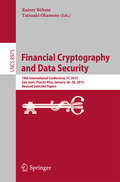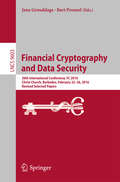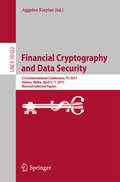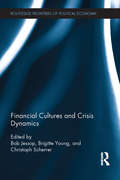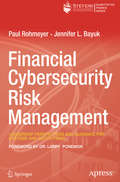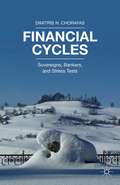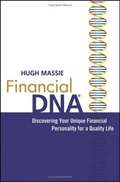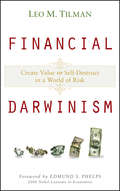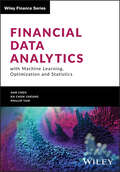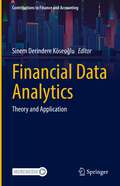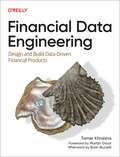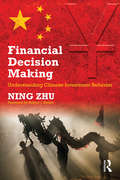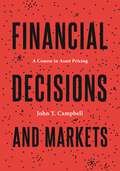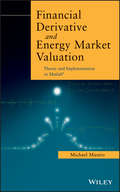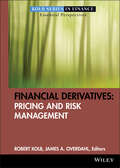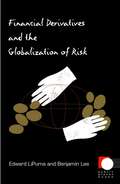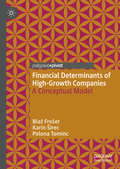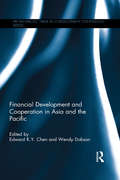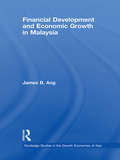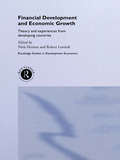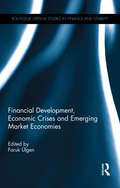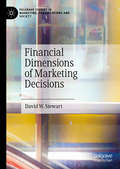- Table View
- List View
Financial Cryptography and Data Security
by Rainer Böhme Tatsuaki OkamotoThis book constitutes the thoroughly refereed post-conference proceedings of the 19th International Conference on Financial Cryptography and Data Security, FC 2014, held in San Juan, Puerto Rico, in January 2015. The 23 revised full papers and 10 short papers were carefully selected and reviewed from 102 full papers submissions. The papers are grouped in the following topical sections: sidechannels; cryptography in the cloud; payment and fraud detection; authentication and access control; cryptographic primitives; mobile security; privacy and incentives; applications and attacks; authenticated data structures.
Financial Cryptography and Data Security: 20th International Conference, FC 2016, Christ Church, Barbados, February 22–26, 2016, Revised Selected Papers (Lecture Notes in Computer Science #9603)
by Jens Grossklags and Bart PreneelThis book constitutes the thoroughly refereed post-conference proceedings of the 20th International Conference on Financial Cryptography and Data Security, FC 2016, held in Christ church, Barbados, in February 2016. The 27 revised full papers and 9 short papers were carefully selected and reviewed from 137 full papers submissions. The papers are grouped in the following topical sections: fraud and deception; payments, auctions, and e-voting; multiparty computation; mobile malware; social interaction and policy; cryptanalysis; surveillance and anonymity; Web security and data privacy; Bitcoin mining; cryptographic protocols; payment use and abuse.
Financial Cryptography and Data Security: 21st International Conference, FC 2017, Sliema, Malta, April 3-7, 2017, Revised Selected Papers (Lecture Notes in Computer Science #10322)
by Aggelos KiayiasThis volume contains the workshopproceedings of the accompanying workshops of the 14th Financial Cryptograpy and Data Security International Conference 2010, held on Tenerife, Canary Islands, Spain, January 25-28, 2010. FinancialCryptographyandData Securityis a majorinternationalforumfor research, advanced development, education, exploration, and debate regarding information assurance, with a speci?c focus on commercial contexts. The c- ference covers all aspects of securing transactions and systems and especially encourages original work focusing on both fundamental and applied real-world deployments on all aspects surrounding commerce security. Three workshops were co-located with FC 2010: the Workshop on Real-Life CryptographicProtocolsandStandardization(RLCPS),theWorkshoponEthics in Computer Security Research (WECSR), and the Workshop on Lightweight Cryptography for Resource-Constrained Devices (WLC). Intimate and colorful by tradition, the high-quality program was not the only attraction of FC. In the past, FC conferences have been held in highly research-synergistic locations such as Tobago, Anguilla, Dominica, Key West, Guadelupe, Bermuda, the Grand Cayman, and Cozumel Mexico. 2010 was the ?rst year that the conference was held on European soil, in the Spanish Canary Islands, in Atlantic waters, a few miles across Morocco. Over 100 researchers from more than 20 countries were in attendance.
Financial Cultures and Crisis Dynamics (Routledge Frontiers of Political Economy)
by Brigitte Young Bob Jessop Christoph ScherrerThe recent financial crisis exposed both a naïve faith in mathematical models to manage risk and a crude culture of greed that embraces risk. This book explores cultures of finance in sites such as corporate governance, hedge funds, central banks, the City of London and Wall Street, and small and medium enterprises. It uses different methods to explore these cultures and their interaction with different financial orders to improve our understanding of financial crisis dynamics. The introduction identifies types of cultural turn in studies of finance. Part I outlines relevant research methods, including comparison of national cultures viewed as independent variables, cultural political economy, and critical discourse and narrative policy analysis. Part II examines different institutional cultures of finance and the cult of entrepreneurship. Part III offers historical, comparative, and contemporary analyses of financial regimes and their significance for crisis dynamics. Part IV explores organizational cultures, modes of calculation, and financial practices and how they shape economic performance and guide crisis management. Part V considers crisis construals and responses in the European Union and China. This book’s great strength is its multi-faceted approach to cultures of finance. Contributors deploy the cultural turn creatively to enhance comparative and historical analysis of financial regimes, institutions, organizations, and practices as well as their roles in crisis generation, construal, and management. Developing different paradigms and methods and elaborating diverse case studies, the authors illustrate not only how and why ‘culture matters’ but also how its significance is shaped by different financial regimes and contexts.
Financial Cybersecurity Risk Management: Leadership Perspectives and Guidance for Systems and Institutions
by Jennifer L. Bayuk Paul RohmeyerUnderstand critical cybersecurity and risk perspectives, insights, and tools for the leaders of complex financial systems and markets. This book offers guidance for decision makers and helps establish a framework for communication between cyber leaders and front-line professionals. Information is provided to help in the analysis of cyber challenges and choosing between risk treatment options.Financial cybersecurity is a complex, systemic risk challenge that includes technological and operational elements. The interconnectedness of financial systems and markets creates dynamic, high-risk environments where organizational security is greatly impacted by the level of security effectiveness of partners, counterparties, and other external organizations. The result is a high-risk environment with a growing need for cooperation between enterprises that are otherwise direct competitors. There is a new normal of continuous attack pressures that produce unprecedented enterprise threats that must be met with an array of countermeasures. Financial Cybersecurity Risk Management explores a range of cybersecurity topics impacting financial enterprises. This includes the threat and vulnerability landscape confronting the financial sector, risk assessment practices and methodologies, and cybersecurity data analytics. Governance perspectives, including executive and board considerations, are analyzed as are the appropriate control measures and executive risk reporting.What You’ll LearnAnalyze the threat and vulnerability landscape confronting the financial sectorImplement effective technology risk assessment practices and methodologiesCraft strategies to treat observed risks in financial systemsImprove the effectiveness of enterprise cybersecurity capabilitiesEvaluate critical aspects of cybersecurity governance, including executive and board oversightIdentify significant cybersecurity operational challengesConsider the impact of the cybersecurity mission across the enterpriseLeverage cybersecurity regulatory and industry standards to help manage financial services risksUse cybersecurity scenarios to measure systemic risks in financial systems environmentsApply key experiences from actual cybersecurity events to develop more robust cybersecurity architecturesWho This Book Is For Decision makers, cyber leaders, and front-line professionals, including: chief risk officers, operational risk officers, chief information security officers, chief security officers, chief information officers, enterprise risk managers, cybersecurity operations directors, technology and cybersecurity risk analysts, cybersecurity architects and engineers, and compliance officers
Financial Cycles
by Dimitris N. ChorafasChorafas argues that to overcome the more narrow limits of the business cycle, we need to go beyond its traditional six to seven year focus and address the longer term.
Financial DNA: Discovering Your Unique Financial Personality for a Quality Life
by Hugh MassieHugh addresses what I believe is the most important aspect of achieving economic freedom: Know Thyself The financial planning community owes a great deal to Hugh for his contributions. ----Elizabeth Jetton, CFP, Strategic Advisor, Mercer Advisors, Inc.
Financial Darwinism
by Leo M. Tilman Edmund PhelpsIn Financial Darwinism, author Leo Tilman lays the groundwork for understanding the new financial order by introducing his evolutionary thesis and then outlines an actionable decision-making framework that enables financial institutions and investors to fully leverage the power of business strategy, corporate finance, investment analysis, and risk management. Financial Darwinism is an invaluable road map to today's financial world and an essential guide to surviving and thriving during these challenging times.
Financial Data Analytics with Machine Learning, Optimization and Statistics (Wiley Finance)
by Phillip Yam Sam Chen Ka Chun CheungAn essential introduction to data analytics and Machine Learning techniques in the business sector In Financial Data Analytics with Machine Learning, Optimization and Statistics, a team consisting of a distinguished applied mathematician and statistician, experienced actuarial professionals and working data analysts delivers an expertly balanced combination of traditional financial statistics, effective machine learning tools, and mathematics. The book focuses on contemporary techniques used for data analytics in the financial sector and the insurance industry with an emphasis on mathematical understanding and statistical principles and connects them with common and practical financial problems. Each chapter is equipped with derivations and proofs—especially of key results—and includes several realistic examples which stem from common financial contexts. The computer algorithms in the book are implemented using Python and R, two of the most widely used programming languages for applied science and in academia and industry, so that readers can implement the relevant models and use the programs themselves. The book begins with a brief introduction to basic sampling theory and the fundamentals of simulation techniques, followed by a comparison between R and Python. It then discusses statistical diagnosis for financial security data and introduces some common tools in financial forensics such as Benford's Law, Zipf's Law, and anomaly detection. The statistical estimation and Expectation-Maximization (EM) & Majorization-Minimization (MM) algorithms are also covered. The book next focuses on univariate and multivariate dynamic volatility and correlation forecasting, and emphasis is placed on the celebrated Kelly's formula, followed by a brief introduction to quantitative risk management and dependence modelling for extremal events. A practical topic on numerical finance for traditional option pricing and Greek computations immediately follows as well as other important topics in financial data-driven aspects, such as Principal Component Analysis (PCA) and recommender systems with their applications, as well as advanced regression learners such as kernel regression and logistic regression, with discussions on model assessment methods such as simple Receiver Operating Characteristic (ROC) curves and Area Under Curve (AUC) for typical classification problems. The book then moves on to other commonly used machine learning tools like linear classifiers such as perceptrons and their generalization, the multilayered counterpart (MLP), Support Vector Machines (SVM), as well as Classification and Regression Trees (CART) and Random Forests. Subsequent chapters focus on linear Bayesian learning, including well-received credibility theory in actuarial science and functional kernel regression, and non-linear Bayesian learning, such as the Naïve Bayes classifier and the Comonotone-Independence Bayesian Classifier (CIBer) recently independently developed by the authors and used successfully in InsurTech. After an in-depth discussion on cluster analyses such as K-means clustering and its inversion, the K-nearest neighbor (KNN) method, the book concludes by introducing some useful deep neural networks for FinTech, like the potential use of the Long-Short Term Memory model (LSTM) for stock price prediction. This book can help readers become well-equipped with the following skills: To evaluate financial and insurance data quality, and use the distilled knowledge obtained from the data after applying data analytic tools to make timely financial decisions To apply effective data dimension reduction tools to enhance supervised learning To describe and select suitable data analytic tools as introduced above for a given dataset depending upon classification or regression prediction purpose The book covers the competencies tested by several professional examinations, such as the Predictive Analytics Exam offered by the Society of Actuaries, and the Institute and Faculty of Actu
Financial Data Analytics: Theory and Application (Contributions to Finance and Accounting)
by Sinem Derindere KöseoğluThis book presents both theory of financial data analytics, as well as comprehensive insights into the application of financial data analytics techniques in real financial world situations. It offers solutions on how to logically analyze the enormous amount of structured and unstructured data generated every moment in the finance sector. This data can be used by companies, organizations, and investors to create strategies, as the finance sector rapidly moves towards data-driven optimization.This book provides an efficient resource, addressing all applications of data analytics in the finance sector. International experts from around the globe cover the most important subjects in finance, including data processing, knowledge management, machine learning models, data modeling, visualization, optimization for financial problems, financial econometrics, financial time series analysis, project management, and decision making. The authors provide empirical evidence as examples of specific topics. By combining both applications and theory, the book offers a holistic approach. Therefore, it is a must-read for researchers and scholars of financial economics and finance, as well as practitioners interested in a better understanding of financial data analytics.
Financial Data Engineering: Design and Build Data-Driven Financial Products
by Tamer KhraishaToday, investment in financial technology and digital transformation is reshaping the financial landscape and generating many opportunities. Too often, however, engineers and professionals in financial institutions lack a practical and comprehensive understanding of the concepts, problems, techniques, and technologies necessary to build a modern, reliable, and scalable financial data infrastructure. This is where financial data engineering is needed.A data engineer developing a data infrastructure for a financial product possesses not only technical data engineering skills but also a solid understanding of financial domain-specific challenges, methodologies, data ecosystems, providers, formats, technological constraints, identifiers, entities, standards, regulatory requirements, and governance.This book offers a comprehensive, practical, domain-driven approach to financial data engineering, featuring real-world use cases, industry practices, and hands-on projects.You'll learn:The data engineering landscape in the financial sectorSpecific problems encountered in financial data engineeringThe structure, players, and particularities of the financial data domainApproaches to designing financial data identification and entity systemsFinancial data governance frameworks, concepts, and best practicesThe financial data engineering lifecycle from ingestion to productionThe varieties and main characteristics of financial data workflowsHow to build financial data pipelines using open source tools and APIsTamer Khraisha, PhD, is a senior data engineer and scientific author with more than a decade of experience in the financial sector.
Financial Decision Making: Understanding Chinese Investment Behavior
by Ning ZhuThis book sheds light on financial decision making and lays down the major biases in human behavioral decision making, such as over-confidence, naive extrapolation, attention, and risk aversion, and how they lead investors and corporations to make considerable mistakes in investment. It draws on a large body of literature, from psychology and social psychology to, most importantly, behavioral economics and behavioral finance. It also looks at the progress in behavioral finance research over recent decades and includes research outputs based on retail and institutional investors from the United States, China, and many other international financial markets. The book focuses on China’s financial reforms and economic transition and includes many cases from that country to highlight the importance of behavioral finance and investor education. It therefore provides much needed in-depth understanding of the Chinese capital market.
Financial Decisions and Markets: A Course in Asset Pricing
by John Y. CampbellFrom the field's leading authority, the most authoritative and comprehensive advanced-level textbook on asset pricingIn Financial Decisions and Markets, John Campbell, one of the field&’s most respected authorities, provides a broad graduate-level overview of asset pricing. He introduces students to leading theories of portfolio choice, their implications for asset prices, and empirical patterns of risk and return in financial markets. Campbell emphasizes the interplay of theory and evidence, as theorists respond to empirical puzzles by developing models with new testable implications. The book shows how models make predictions not only about asset prices but also about investors&’ financial positions, and how they often draw on insights from behavioral economics.After a careful introduction to single-period models, Campbell develops multiperiod models with time-varying discount rates, reviews the leading approaches to consumption-based asset pricing, and integrates the study of equities and fixed-income securities. He discusses models with heterogeneous agents who use financial markets to share their risks, but also may speculate against one another on the basis of different beliefs or private information. Campbell takes a broad view of the field, linking asset pricing to related areas, including financial econometrics, household finance, and macroeconomics. The textbook works in discrete time throughout, and does not require stochastic calculus. Problems are provided at the end of each chapter to challenge students to develop their understanding of the main issues in financial economics.The most comprehensive and balanced textbook on asset pricing available, Financial Decisions and Markets is an essential resource for all graduate students and practitioners in finance and related fields.Integrated treatment of asset pricing theory and empirical evidenceEmphasis on investors&’ decisionsBroad view linking the field to financial econometrics, household finance, and macroeconomicsTopics treated in discrete time, with no requirement for stochastic calculusSolutions manual for problems available to professors
Financial Deepening in the CFA Franc Zone: The Role of Institutions
by Kangni Kpodar Dhaneshwar Ghura Raju Jan SinghA report from the International Monetary Fund.
Financial Derivative and Energy Market Valuation
by Michael MastroA road map for implementing quantitative financial modelsFinancial Derivative and Energy Market Valuation brings the application of financial models to a higher level by helping readers capture the true behavior of energy markets and related financial derivatives. The book provides readers with a range of statistical and quantitative techniques and demonstrates how to implement the presented concepts and methods in Matlab®.Featuring an unparalleled level of detail, this unique work provides the underlying theory and various advanced topics without requiring a prior high-level understanding of mathematics or finance. In addition to a self-contained treatment of applied topics such as modern Fourier-based analysis and affine transforms, Financial Derivative and Energy Market Valuation also:* Provides the derivation, numerical implementation, and documentation of the corresponding Matlab for each topic* Extends seminal works developed over the last four decades to derive and utilize present-day financial models* Shows how to use applied methods such as fast Fourier transforms to generate statistical distributions for option pricing* Includes all Matlab code for readers wishing to replicate the figures found throughout the bookThorough, practical, and easy to use, Financial Derivative and Energy Market Valuation is a first-rate guide for readers who want to learn how to use advanced numerical methods to implement and apply state-of-the-art financial models. The book is also ideal for graduate-level courses in quantitative finance, mathematical finance, and financial engineering.
Financial Derivatives
by James A. Overdahl Robert KolbEssential insights on the various aspects of financial derivativesIf you want to understand derivatives without getting bogged down by the mathematics surrounding their pricing and valuation, Financial Derivatives is the book for you. Through in-depth insights gleaned from years of financial experience, Robert Kolb and James Overdahl clearly explain what derivatives are and how you can prudently use them within the context of your underlying business activities.Financial Derivatives introduces you to the wide range of markets for financial derivatives. This invaluable guide offers a broad overview of the different types of derivatives-futures, options, swaps, and structured products-while focusing on the principles that determine market prices. This comprehensive resource also provides a thorough introduction to financial derivatives and their importance to risk management in a corporate setting. Filled with helpful tables and charts, Financial Derivatives offers a wealth of knowledge on futures, options, swaps, financial engineering, and structured products.Discusses what derivatives are and how you can prudently implement them within the context of your underlying business activitiesProvides thorough coverage of financial derivatives and their role in risk managementExplores financial derivatives without getting bogged down by the mathematics surrounding their pricing and valuationThis informative guide will help you unlock the incredible potential of financial derivatives.
Financial Derivatives and the Globalization of Risk
by Benjamin Lee Edward LipumaThe market for financial derivatives is far and away the largest and most powerful market in the world, and it is growing exponentially. In 1970 the yearly valuation of financial derivatives was only a few million dollars. By 1980 the sum had swollen to nearly one hundred million dollars. By 1990 it had climbed to almost one hundred billion dollars, and in 2000 it approached one hundred trillion. Created and sustained by a small number of European and American banks, corporations, and hedge funds, the derivatives market has an enormous impact on the economies of nations--particularly poorer nations--because it controls the price of money. Derivatives bought and sold by means of computer keystrokes in London and New York affect the price of food, clothing, and housing in Johannesburg, Kuala Lumpur, and Buenos Aires. Arguing that social theorists concerned with globalization must familiarize themselves with the mechanisms of a world economy based on the rapid circulation of capital, Edward LiPuma and Benjamin Lee offer a concise introduction to financial derivatives. LiPuma and Lee explain how derivatives are essentially wagers--often on the fluctuations of national currencies--based on models that aggregate and price risk. They describe how these financial instruments are changing the face of capitalism, undermining the power of nations and perpetrating a new and less visible form of domination on postcolonial societies. As they ask: How does one know about, let alone demonstrate against, an unlisted, virtual, offshore corporation that operates in an unregulated electronic space using a secret proprietary trading strategy to buy and sell arcane financial instruments? LiPuma and Lee provide a necessary look at the obscure but consequential role of financial derivatives in the global economy.
Financial Derivatives: Pricing, Applications, and Mathematics
by Jamil Baz George ChackoCombining their corporate and academic experiences, Jamil Baz and George Chacko offer financial analysts a complete, succinct account of the principles of financial derivatives pricing. Readers with a basic knowledge of finance, calculus, probability and statistics will learn about the most powerful tools in applied finance: equity derivatives, interest rate markets, and the mathematics of pricing. Baz and Chacko apply concepts such as volatility and time, and generic pricing to the valuation of conventional and more specialized cases. Other topics include: *Interest rate markets, government and corporate bonds, swaps, caps, and swaptions *Factor models and term structure consistent models *Mathematical allocation decisions such as mean-reverting processes and jump processes *Stochastic calculus and related tools such as Kilmogorov equations, martingales techniques, stocastic control and partial differential equations Meant for financial analysts and graduate students in finance and economics, Financial Derivatives begins with basic economic principles of risk and builds up various pricing and hedging techniques from those principles. Baz and Chacko simplify the mathematical presentation, and balance theory and real analysis, making it a more accessible and practical manual. Jamil Baz holds an M. S. in Management from MIT and a Ph. D. in Business Economics from Harvard University. He is a Managing Director at Deutsche Bank in London. George Chacko has a B. S. from MIT in electrical engineering and a Ph. D. in Business Economics from Harvard University. He is an Associate Professor of Business Administration at Harvard Business School. Both authors have worked extensively for financial services firms in the private sector. They have published in leading academic journals including the Review of Financial Studies and the Journal of Financial Economics as well as practitioner journals such as the Journal of Fixed Income and the Journal of Applied Corporate Finance.
Financial Determinants of High-Growth Companies: A Conceptual Model
by Polona Tominc Blaž Frešer Karin ŠirecThis book explores the factors that contribute to high corporate growth, presenting a new conceptual model for research into this phenomenon.Building on existing research, the authors present a new conceptual research model that links multidimensional variables, such as entrepreneurial orientation, and human capital, with the perceived availability of different forms of financing for high-growth companies and with the measures that these firms take to overcome financial constraints and thus influence their financial performance. With this model the authors aim to enhance our understanding of the specifics of financing high growth companies and demonstrate how the availability of financial resources is one of the most important determinants of promoting development and enterprise growth. Empirically tested on a random sample of high-growth companies from Slovenia, the book seeks to make a contribution to research and enhance our understanding of the various factors involved in high growth firms.
Financial Development and Cooperation in Asia and the Pacific (PAFTAD (Pacific Trade and Development Conference Series))
by Wendy Dobson Edward K. ChenThe 1997–8 Asian financial crisis exposed weaknesses in the region’s national financial systems, but since then East Asia has become the world’s most dynamic economic region. Domestic financial systems have developed, cross-border financial flows within the region are growing apace as demand from governments and large firms increases and as the capabilities of financial institutions develop, and governments have initiated regional cooperation aimed at preventing future crises and managing them if they occur. This book examines the economies of Asia and the Pacific with reference to financial reform and liberalization, monetary policy frameworks, banking and capital markets, regulation and supervision and macroeconomic policies. Further, it asks what lessons have been learned from both the Asian financial crisis and the recent financial crisis, how to engender financial stability in the region, and how to ensure that the benefits of economic growth and financial development reach all members of society. Across four key sections, the chapters examine the future implications of historical studies of the relationships between financial development and growth; financial development including banks, non-bank financial institutions and capital markets; how financial stability is being sought in the region; and China’s plans for capital account opening and renminbi internationalization and subsequent the policy implications for China’s neighbours. This book draws on papers originally presented to the 36th Pacific Trade and Development Conference held in Hong Kong in 2013, and features contributions from leading academics and economists from around the world. As such, it will be of great interest to students and scholars of Asian economics, Asia Pacific studies, international economics and international finance.
Financial Development and Economic Growth in Malaysia (Routledge Studies in the Growth Economies of Asia)
by James B. AngThis book is concerned with the role of financial intermediation in economic development and growth in the context of Malaysia. Using an analytical framework, the author investigates the Malaysian economy from 1960 onwards to examine how far financial development has progressed in the course of economic development, and whether it has been instrumental in promoting economic growth. A significant improvement in the Malaysian financial system, coupled with rapid economic growth and a rich history of financial sector reforms, makes Malaysia an interesting case study for this subject. The author shows that some government interventions seem to have impacted negatively on economic growth, whereas repressionist financial policies such as interest rate controls, high reserve requirements and directed credit programmes seem to have contributed positively to financial development. The analysis concludes that financial development leads to higher output growth via promoting private saving and private investment. Shedding light on the evolutionary role of financial system and the interacting mechanisms between financial development and economic growth, this book will be of interest to those interested in economic and financial development, financial liberalization, saving behaviour and investment analysis and Asian Studies.
Financial Development and Economic Growth: Theory and Experiences from Developing Countries (Routledge Studies in Development Economics #No.6)
by Robert Lensink Niels HermesThis collection brings together a collection of theoretical and empirical findings on aspects of financial development and economic growth in developing countries. The book is divided into two parts: the first identifies and analyses the major theoretical issues using examples from developing countries to illustrate how these work in practice; the second part looks at the implications for financial policy in developing countries.
Financial Development in the Middle East and North Africa
by Rishi Goyal Susan Creane A. Mushfiq Mobarak Randa SabIn this study, the authors assess financial sector development in the MENA region and propose several policy measures, which include reinforcing the institutional environment and promoting nonbank financial sector development, to enhance this sector's performance.
Financial Development, Economic Crises and Emerging Market Economies (Routledge Critical Studies in Finance and Stability)
by Faruk UlgenRecurrent crises in emerging markets and in advanced economies in the last decades cast doubt about the ability of financial liberalization to meet the aims of sustainable economic growth and development. The increasing importance of financial markets and financial efficiency criterion over economic decisions and policies since the 1980s laid down the conditions of the development process of emerging market economies. Numerous crises experienced thereafter gave rise to flourishing work on the links between financialization and economic development. Several decades of observations and lessons can now be integrated into economic and econometric models to give more sophisticated and multivariable approaches to financial development with respect to growth and development issues. In the markets-based and private-enterprise dominated world economy, two conditions for a successful growth-enhancing financial evolution can at least be brought fore: macroeconomic stability and consistent supervision. But even after the 2007-2008 global crisis, economists do not agree on the meaning of those conditions. For liberal and equilibrium-market economists, good finance and supervision mean market-friendly structures while for institutionalists, post-Keynesian and Marxist economists, good finance and supervision must lie in collectively designed and managed public structures. Drawing heavily on the tumultuous crises of the 1990s-2000s, this book argues that those experiences can shed light on such a crucial issue and lead economic theory and policy to go beyond the blindness of efficient free markets doctrine to economic catastrophes. It also points to new challenges to global stability in the wake of reconfiguration of international financial arena under the weight of major emerging market economies.
Financial Dimensions of Marketing Decisions (Palgrave Studies in Marketing, Organizations and Society)
by David W. StewartThis book is about linking marketing activities and outcomes to the financial performance of the organization. The theme of the book is that the marketing function must justify its activities and use of resources in terms of its financial contributions to the firm. More specifically, the book focuses on how marketing activities generate cash flow, growth, and other financial benefits for the organization. This perspective provides a framework for long-term investments for purposes of evaluating and ranking the funding of proposed projects.
